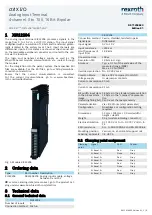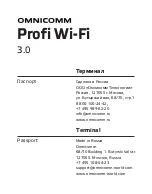
SCXI-1321 Terminal Block Installation Guide
8
ni.com
Note
Refer to the Declaration of Conformity (DoC) for this product for any additional
regulatory compliance information. To obtain the DoC for this product, click
Declarations
of Conformity Information
at
ni.com/hardref.nsf/
.
Performed or Supported Signal Conditioning
This section provides information on types of signal conditioning
performed by the SCXI-1321 or is supported by it.
Offset Nulling
Offset nulling is a hardware nulling procedure used with
Wheatstone-bridge transducers that have an initial offset error. Correcting
this error improves measurement accuracy. The nulling circuitry operates
with quarter-bridge, half-bridge, and full-bridge strain-gauge
configurations. Each channel has its own nulling circuitry and its own
trimming potentiometer as listed in Table 1.
To null the static offset voltage of the bridge, complete the following steps:
1.
Connect the bridge configuration to the selected channel.
2.
Select and read the channel output.
3.
While monitoring the output, rotate the trimmer wiper with a flathead
screwdriver until you reach 0 V.
You have nulled the bridge and are ready for a measurement.
The nulling range that is provided with the terminal block is ±2.5 mV,
assuming that you have a 120
Ω
strain gauge quarter-bridge configuration
and 3.3 V excitation voltage. You can change this range by replacing the
nulling resistor with a resistor of another value. Each channel has an
independent socketed nulling resistor. Therefore, you can mix the ranges to
accommodate each channel requirement. Table 2 lists the nulling resistors
and their corresponding channels.
Table 1.
Trimmer Potentiometers and Corresponding Channels
Channel Number
Trimmer Potentiometer
0
R1
1
R2
2
R14
3
R15


































